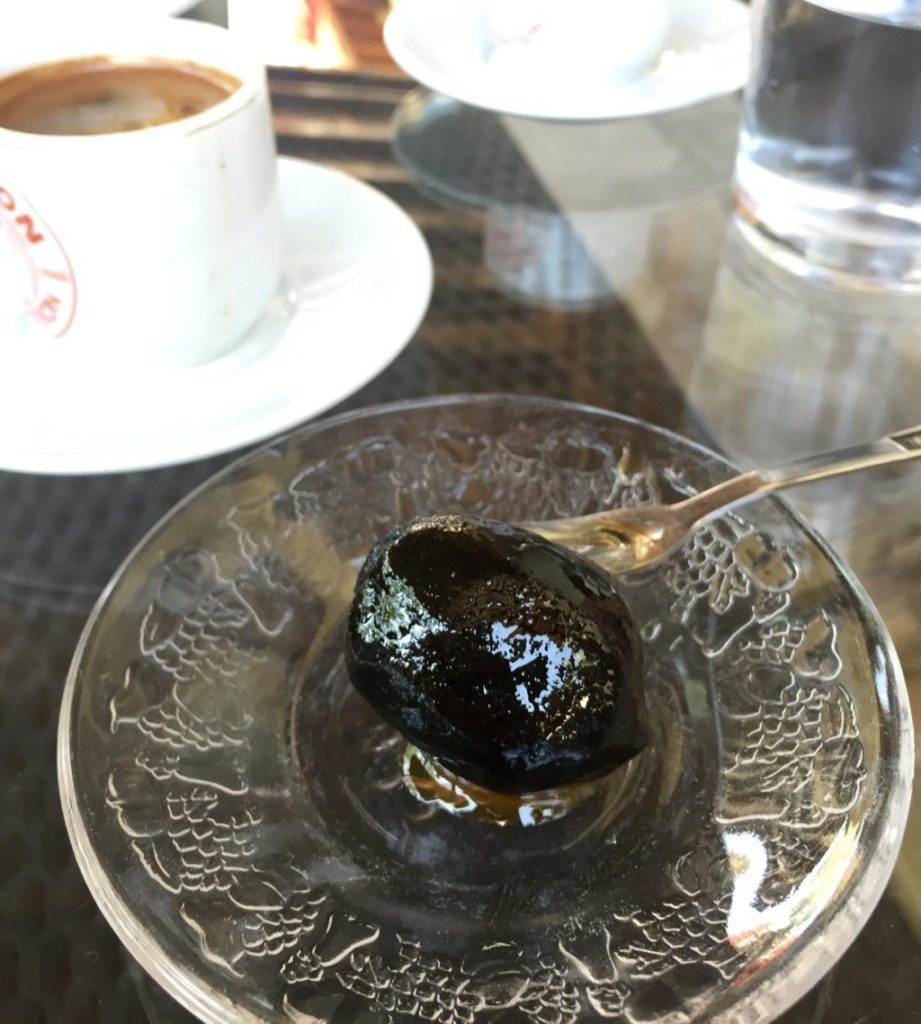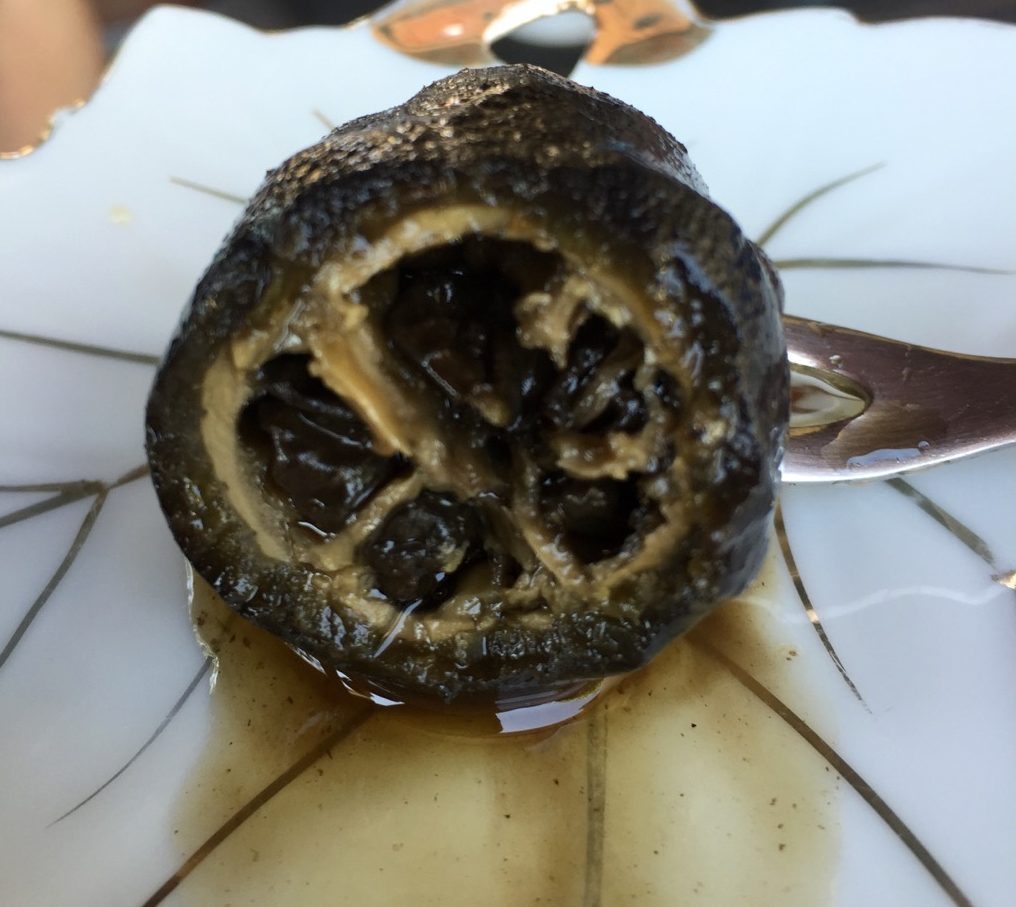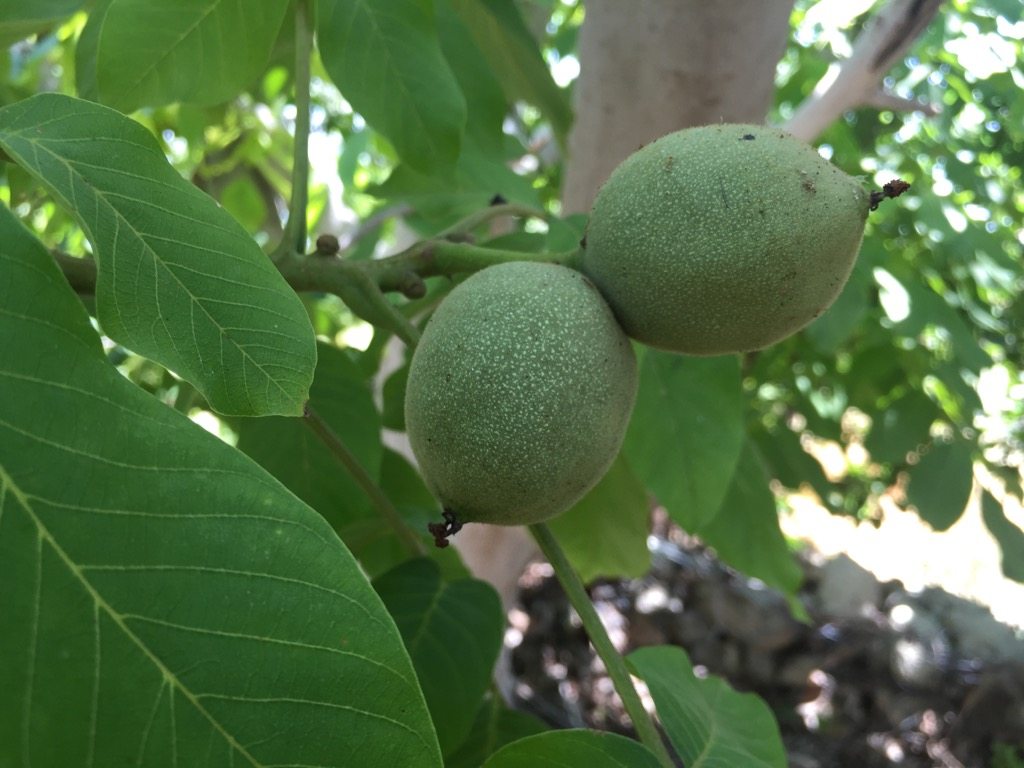Here’s a delicious Cypriot sweet that I bet you’ve never heard of – Karidaki Glyko – a fresh whole walnut, husk, shell and nut, that’s been leached and then placed in a jar with sugar or honey syrup. It’s exquisite and not like anything else I’ve tasted. The texture is almost spongy, but firm to the bite.
We did find some for sale at the Larnaca Airport in Cyprus, but they weren’t nearly as good at Nitsa’s. Nitsa is the wife of Zorba’s long lost cousin, who we found on our recent trip to Cyprus. You can read about that chance encounter here.
When I asked, Nitsa how she made these walnuts, her explanation, in Greek, was quite complicated – let’s just say it wasn’t a two minute conversation. Making Karidaki Glyko doesn’t sound difficult but it is quite a lengthy process. If you are ever offered one, be sure to accept so you can try these sweet delicious treats for yourself.
Karidaki Glyko
Recipe from Cypriot and Proud website
(with edits from me with what Nitsa told me)
The whole walnut fruit* has to be soaked in water for seven days, changing the water daily. On the eighth day, add lime powder (which contains calcium hydroxide) to fresh water. Then you have to wash the walnuts three times. You have to be very careful to rinse the walnuts very well after a day soaked in that.
Then pierce the walnuts, stick a clove in each one and make the honey syrup with cinnamon and cloves. I found a recipe on Cypriot and Proud blog that is almost identical to the way Nitsa explained how to make these sweet delicious walnut sweets- here it is below.
- You need to use young walnuts that aren’t yet mature. In Cyprus, they traditionally pick the walnuts for glyko on 24 June. You can tell the walnuts are ready to use when you cut little triangles / wedges from the top and bottom of the nut and are able to remove any shell that has started to form. If you cannot remove all of the shell that has started to form, then it may be that your walnuts are too big and too far matured to make “glyko”.
Ingredients
50 fresh young walnuts* – see above
2 kg of sugar
1 cup lime powder – see note below. It’s the traditional recipe, but I recommend you use the juice from one lemon instead
about 6-7 lemons
1 cinnamon stick
1 tbs whole cloves
5 cups water
Method
- Peel the walnuts. Wear gloves when doing this as your hands will otherwise turn black from the iodine naturally present in the walnuts.
- Cut the tips off the walnuts using a triangle / wedge shape
- Pierce each walnut with a skewer vertically.
- Put the walnuts in a bowl covered with water. Leave for one week and change the water daily.
- On the 7th day, change the water and put 1 cup of lime (about 225 grams) or rather the juice from one lemon in the water with the walnuts. Let rest for 4 hours. Then wash the walnuts at least 3 times and very thoroughly to rinse the lime out (if using) and then place in a large pot of water.
- Bring the pot of water with the walnuts to a boil for about 2-3 minutes. Empty the water and refill with cold water. Bring again to a boil. Empty the water.
- Add the juice of 4-5 lemons and as much water as needed to cover the walnuts. Leave for an hour. The lemon juice helps the walnuts to become shiny and crisp.
- Empty the water. In a clean saucepan add the sugar and about 4-5 cups of water. Heat the mixture on the stove until the sugar melts. Add the walnuts to the mixture and on medium heat allow the mixture to cook and foam for about 7 minutes. Let cool on the stove and cover with a lid.
- For the next 3 days, bring the mixture to a boil for about ten minutes each time. On the 3rd day (ie the fourth time boiling the mixture), add the cloves and cinnamon, boil and let the mixture reach setting point, which is when the sugar syrup slowly drops off a spoon. Also test to make sure that the walnuts are cooked. To do this, get a needle and pierce a walnut horizontally. Point the needle towards the ground and let the walnut try to slide off – if it does slide off, the walnut is cooked. Add juice of a half a lemon towards the end.
Note that if you boil the mixture too much, the sugar syrup will being to caramelise
- Let the mixture cool completely and then place the walnuts with syrup in clean and dry glass jars. A good tip to make sure your glass jars are clean and dry is to put them in an oven with the door open at the lowest temperature for about fifteen minutes.
A note on Lime Powder
Lime Powder, otherwise known as pickling powder, contains calcium. When making walnut “glyko” lime powder (calcium hydroxide) is used to preserve the hardness, crunch, of the walnut and prevent them from going mushy. You have to be really careful with this stuff – if not rinsed away properly it has been known to cause botulism. Buy this as pickling lime from a grocery store – NOT anywhere else (like a hardware store). Some say adding lemon juice (much safer option) keeps the walnuts crunchy and makes them glossy.
The only reason I’m telling you about Lime Powder is because it’s traditional – and it’s what Nitsa uses.
I highly recommend making friends with a Cypriot to try these delicious sweets and save yourself the ordeal! Unless you like a challenge, then I say go for it! (and let me know how you go!)
More info
Check out Cypriot and Proud for more traditional Cypriot recipes, and quite entertaining commentary!





Fantastic!!! Thank you so much for sharing this incredible receipt! Yesterday we had it in Athens with a desert and it was so delicious. So we looked it up: and he was your receipt. It’s a lot of little strips but the taste is really delicious and very special! Maybe one day I will try to make it myself.
Best regards, Sigrun
I had to search high and low for the recipe, making this delicious sweet takes a lot of time and patience, perhaps not something many of us are prepared to do in modern times. But yes, it’s absolutely incredible. I’m glad you stopped by. Thank you!